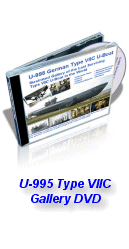

|
Type II U-Boat
 |
||||||||
 |
 |
 |
 |
 |
 |
 |
 |
 |
First launched in June 1935, the Type II were the first U-boats commissioned in German yards after the repudiation of the Versailles Treaty. Unknown to other nations at that time, Germany had already begun construction for 12 new Type II U-boats as early as 1934. It was not until the signing of the Anglo-German Naval Agreement in February 1935 that construction began to be undertaken publicly. By June 15 1935, the first class of the Type II was launched.
|
|
|
|
Authored by Uboataces |

|
Small and cramped, the Type II were coastal boats intended principally for training, but because of the shortage of available boats, they were later relegated to war duties. With a crew of 25, the boats had limited range and carried enough provisions for three to four weeks, but frequently returned to port after expending their supply of torpedoes.
Due to their small size and heavy rolling on the sea, the Type IIs quickly earned the nickname “Dugout Canoes”. Although of limited use in the open ocean, some remarkable successes were accomplished early in the war by U-boat aces such as Otto Kretschmer. The Type II also earned the respect and admiration of the crew due to its high maneuverability, rapid diving time and durability. Later in the war, due to the ever increasing need for training new crews, all Type II U-boats were withdrawn from combat duties and assigned to full-time training.
A total of 50 Type II U-boats were built during the war. There are four variants, Type IIA, IIB, IIC and IID.
Type IIA

The Type IIA was a single hull, all welded boat with internal ballast tanks. Compared to the other variants, it had a smaller bridge and could carry the German G7a, G7e torpedoes as well as TM-type torpedo mines. There was a single periscope in the conning tower with serrated net cutters in the bow. The net cutters were adopted from World War 1 boats but were quickly discontinued during World War 2.
Type IIB

The Type IIB was a lengthened version of the Type IIA. Three additional compartments were inserted amidships which were fitted with additional diesel tanks beneath the control room. The range was increased to 1,800 nautical miles at 12 knots. Diving time was also improved to 30 seconds.
Type IIC

The Type IIC was a further lengthened version of the Type IIB with an additional two compartments inserted amidships to accomodate improved radio room facilities and a second periscope. The additional diesel tanks beneath the control room was further enlarged, extending the range to 1,900 nautical miles at 12 knots.
Type IID

The Type IID had additional saddle tanks fitted to the sides of the external hull. These saddle tanks were used to accomodate additional diesel storage tanks. The diesel oil would float atop the saddle tanks and as the oil is consumed, sea water would gradually fill the tanks to compensate for the positive buoyancy. The range was nearly doubled to 3,450 nautical miles at 12 knots and enabled the Type II to operate around the British Isles. A further development was the propellers were fitted with Kurt nozzles, intended to improve propulsion efficiency.
Technical Specification
| Type IIA | Type IIB | Type IIC | Type IID | |
| Role | Coastal U-boat | Coastal U-boat | Coastal U-boat | Coastal U-boat |
| Displacement Surfaced Submerged |
253.8 tons 301.1 tons |
278.9 tons 328.5 tons |
291 tons 341 tons |
314 tons 364 tons |
| Dimensions Length Beam Draught |
134.2ft (40.9m) 13.4ft (4.1m) 12.5ft (3.8m) |
140.1ft (42.7m) 13.4ft (4.1m) 12.8ft (3.9m) |
144.0ft (43.9m) 13.5ft (4.1m) 12.5ft (3.8m) |
144.4ft (44.0m) 16.4ft (5.0m) 12.8ft (3.9m) |
| Top speed Surfaced Submerged |
13.0 knots 6.9 knots |
13.0 knots 7.0 knots |
12.0 knots 7.0 knots |
12.7 knots 7.4 knots |
| Maximum range Surfaced Surfaced Submerged Submerged |
1,050nm at 12kt 2,000nm at 8kt 35nm at 4kt 71nm at 2kt |
1,800nm at 12kt 3,900nm at 8kt 35nm at 4kt 71nm at 2kt |
1,900nm at 12kt 4,200nm at 8kt 35nm at 4kt 71nm at 2kt |
3,200nm at 12kt 5,680nm at 8kt 56nm at 4kt |
| Crush depth Crash dive time |
328ft (100m) 35secs |
328ft (100m) 30secs |
328ft (100m) 25secs |
328ft (100m) 25secs |
| Weapons Bow tubes Stern tubes Torpedo capacity Mines Guns Ammunition |
Three 21 inch None Six TMA, TMB 20mm Twin Flak 850 rounds |
Three 21 inch None Six TMA, TMB 20mm Twin Flak 1,000 rounds |
Three 21 inch None Six TMA, TMB 20mm Twin Flak 1,000 rounds |
Three 21 inch None Six TMA, TMB 20mm Twin Flak 1,000 rounds |
| Officers and crew | 3 + 22 = 25 | 3 + 22 = 25 | 3 + 22 = 25 | 3 + 22 = 25 |
| Total built | 6 | 20 | 8 | 16 |
| First launch | June 15, 1935 | June 29, 1935 | Sept 3, 1939 | May 18, 1940 |



